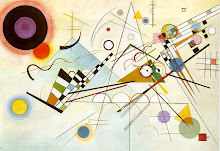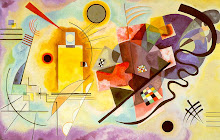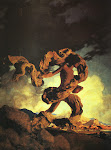Almost Submerged
1930
"Painting is an art, and art is not vague production, transitory
and isolated, but a power which must be directed to the
improvement and refinement of the human soul–to, in fact, the
raising of the spiritual triangle.
If art refrains from doing this work, a chasm remains unbridged,
for no other power can take the place of art in this activity.
And at times when the human soul is gaining greater strength, art
will also grow in power, for the two are inextricably connected
and complementary one to the other. Conversely, at those times
when the soul tends to be choked by material disbelief, art
becomes purposeless and talk is heard that art exists for art's
sake alone."
and isolated, but a power which must be directed to the
improvement and refinement of the human soul–to, in fact, the
raising of the spiritual triangle.
If art refrains from doing this work, a chasm remains unbridged,
for no other power can take the place of art in this activity.
And at times when the human soul is gaining greater strength, art
will also grow in power, for the two are inextricably connected
and complementary one to the other. Conversely, at those times
when the soul tends to be choked by material disbelief, art
becomes purposeless and talk is heard that art exists for art's
sake alone."
– Wassily Kandinsky
Park of St. Cloud with Horseman
1906
Park St. Cloud in Autumn
1906
White Sound
1908
Binz on Rügen
1901
Kochel - Lady Seated by the Lakeside
1902
Shallow-Deep
1930
Moonlit Night
1907
Kochel Waterfall II
1902
.jpg)
.jpg)
.jpg)
.jpg)
.jpg)
.jpg)
.jpg)
.jpg)
.jpg)
.jpg)
.jpg)
.jpg)
.jpg)
.jpg)
.jpg)
.jpg)
.jpg)
.jpg)
.jpg)
.jpg)
.jpg)
.jpg)
.jpg)
.jpg)
.jpg)
.jpg)
.jpg)
.jpeg)
.jpg)
.jpg)
.jpg)
.jpg)
.jpg)
.jpg)
.jpg)
.jpg)
.jpg)
.jpg)
.jpg)
.jpg)
.jpg)
.jpg)
.jpg)
.jpg)
.jpg)
.jpg)
.jpg)
.jpg)
.jpg)
.jpg)
.jpg)
.jpg)
.jpg)
.jpg)






